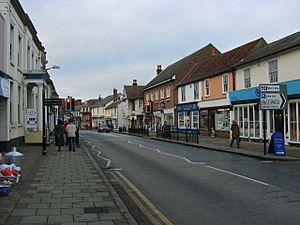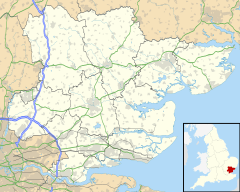Great Dunmow facts for kids
Quick facts for kids Great Dunmow |
|
|---|---|
 High Street, Great Dunmow |
|
| Population | 10,396 (2021 census) |
| OS grid reference | TL628218 |
| Civil parish |
|
| District |
|
| Shire county | |
| Region | |
| Country | England |
| Sovereign state | United Kingdom |
| Post town | DUNMOW |
| Postcode district | CM6 |
| Dialling code | 01371 |
| Police | Essex |
| Fire | Essex |
| Ambulance | East of England |
| EU Parliament | East of England |
| UK Parliament |
|
Great Dunmow is a historic market town in Essex, England. It's located north of the A120 road, about halfway between Bishop's Stortford and Braintree. It's also only about 5 miles (8 km) east of London Stansted Airport.
The town's name, Dunmow, means "Meadow on the Hill." It was once called Dunmow Magna or Much Dunmow, but now it's known as Great Dunmow.
Contents
History of Great Dunmow
Great Dunmow was first settled by the Romans. It grew where two important Roman roads met. One road, called Stane Street, connected Colchester to London. Other roads linked to Sudbury, Cambridge, and Chelmsford.
The main Roman settlement spread west from this road crossing. There were also burial grounds on the edges of the town. Another Roman settlement was found nearby at Church End. This site likely had a Roman temple.
From Roman Times to Medieval Growth
After the Romans left, the town got its name. In AD 951, it was called Dunemowe. Later, it became Dommawe. The Domesday Book of 1086 shows that the area, including Great Dunmow, had seven large estates. Some of these names, like Bigods and Newton Hall, are still used today.
The first church in the town was recorded in 1045. In medieval times, Dunmow became a busy trading center. It was given permission to hold markets in 1253. Two fairs were held every year until the 1800s.
The town's main area of settlement moved over time. It started at Church End, where the parish church is. When the market was allowed, the town center shifted to the High Street and market-place. Today, Great Dunmow has 167 listed buildings, showing its long history.
Great Dunmow During World War II
During the Second World War, Great Dunmow was part of the GHQ Line. This was a series of defenses and concrete pillboxes built to stop a possible German invasion. Many of these pillboxes can still be seen along the River Chelmer. One is located behind the Dourdan Pavilion.
Easton Lodge became RAF Great Dunmow during the war. It was home to air squadrons from the USAAF and the RAF. The land where the airfield once stood might be used for a new housing development in the future.
A nuclear bunker was built near the village in 1959. It was used by the army until the 1980s.
Parish Church
The main church in Great Dunmow is called St Mary the Virgin. It is a very old and important building, listed as Grade I listed building. The current leader of the church is The Reverend Thomas Warmington.
Local Government
Great Dunmow has a civil parish and a parish council. This council helps manage local services and represents the community.
Attractions in Great Dunmow
Great Dunmow has some interesting places to visit.
Maltings Museum
The town museum, called the Maltings Museum, is on Mill Lane. It tells the story of Great Dunmow's local history.
Talliston House & Gardens
Great Dunmow is also home to Talliston House & Gardens. This was once a regular house that was completely transformed by its owner, John Tarrow. It's now known as 'Britain's most extraordinary home'. The house and gardens have 13 fantasy rooms, each designed to look like a different time and place. Visitors have been able to explore it since 2015.
Old Town Hall
The Old Town Hall is in the Market Place. This historic building dates back to the 1500s.
Transportation
Great Dunmow does not have its own train station anymore.
Train Travel
The closest train station is in Braintree, about 8.3 miles (13.4 km) away. From Braintree, trains go to London Liverpool Street in about 63 minutes. Another nearby station is Bishop's Stortford, about 9.2 miles (14.8 km) away. Trains from there reach London Liverpool Street in about 45 minutes.
The town used to have its own train station, Dunmow railway station, which opened in 1869 but closed to passengers in 1952. The old railway line is now a path where you can walk or cycle.
Roads and Buses
Great Dunmow is close to Stansted Airport, which is less than 5 miles (8 km) away by air. The M11 motorway also passes nearby. The A120 bypasses the town, meaning it goes around it instead of through it.
The town has regular bus services. The Arriva Sapphire route 133 and Essex Airlink route X20 both run about once an hour. They connect Stansted Airport, Great Dunmow, and Braintree. The X20 also continues further east to Colchester.
Local Media
Local news and TV shows for Great Dunmow are provided by BBC East and ITV Anglia.
Radio Stations
You can listen to local radio stations like BBC Essex (103.5 FM), Heart Essex (96.1 FM), and Greatest Hits Radio East (100.2 FM). There's also Actual Radio, a DAB station.
Newspaper
The local newspaper for the town is the Dunmow Broadcast. It is published every Thursday.
Flitch Trials
Great Dunmow is famous for its "Flitch Trials," which happen every four years. In this old tradition, married couples try to prove to a jury that they have been happily married for a year and a day. The jury is made up of six local unmarried men and six local unmarried women.
If a couple succeeds, they are paraded through the High Street. They also receive a flitch of bacon (a side of bacon) as their prize. This custom is very old and is even mentioned in Chaucer's famous book, The Canterbury Tales.
Twin Town
Great Dunmow is twinned with Dourdan in France. This means the two towns have a special friendship and often exchange visits.
Notable People from Great Dunmow
Many interesting people have connections to Great Dunmow:
- Evelyn Anthony (1926–2018) – a well-known novelist and writer.
- Anne Line (1567–1601) – a Catholic martyr who was executed for helping a priest.
- Lionel Lukin (1742–1834) – some believe he invented the unsinkable lifeboat. He tested his designs on Doctor's Pond in the town.
- Sir George Beaumont, 7th Baronet (1753–1827) – an art supporter and painter who helped create London's National Gallery.
- Julian Byng, 1st Viscount Byng of Vimy (1862–1935) – an army officer who became the Governor General of Canada.
- Toke Townley (1912–1984) – an actor who was a regular character in the TV show Emmerdale Farm.
- Francis Arthur Jefferson (1921–1982) – a brave soldier who received the Victoria Cross.
- Glen Murphy – an actor and producer.
- Tommy Walsh – a famous builder from TV shows like Ground Force.
- Liam Howlett – a member of the music group The Prodigy, lives in Great Dunmow.
- Alex Lynn – a racing driver.
- Jonathan Albon – a long-distance runner.
See also
 In Spanish: Great Dunmow para niños
In Spanish: Great Dunmow para niños






